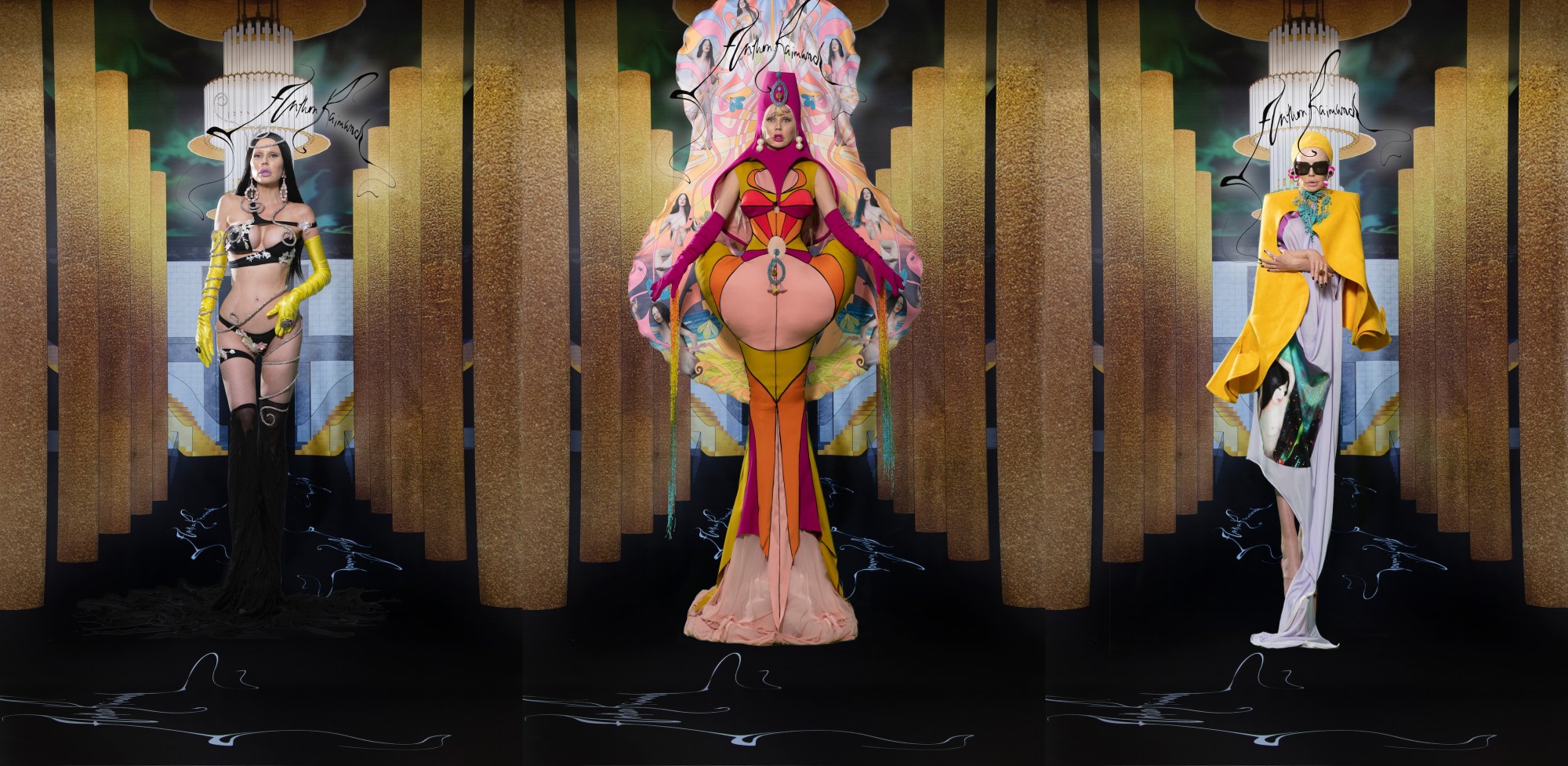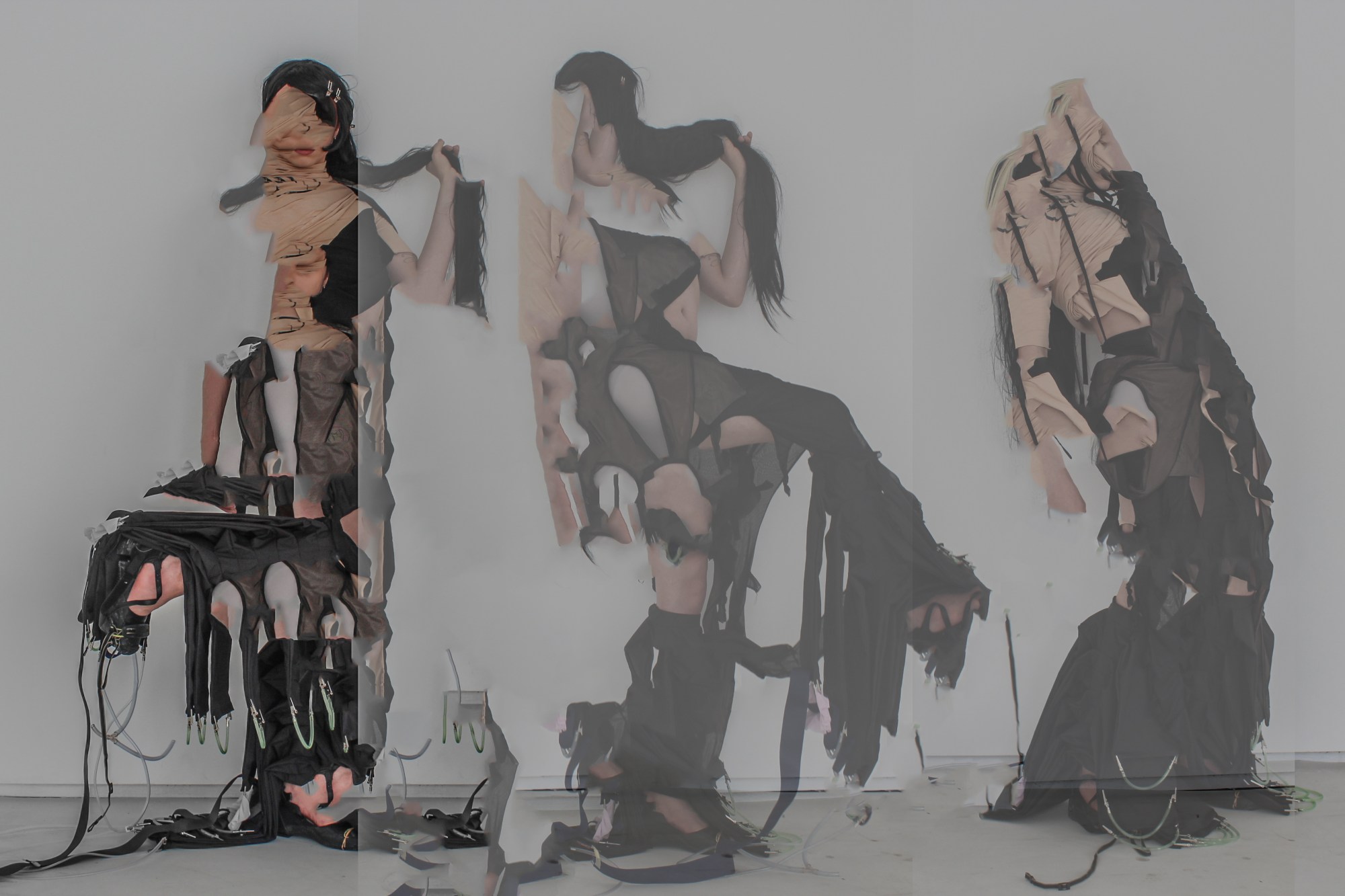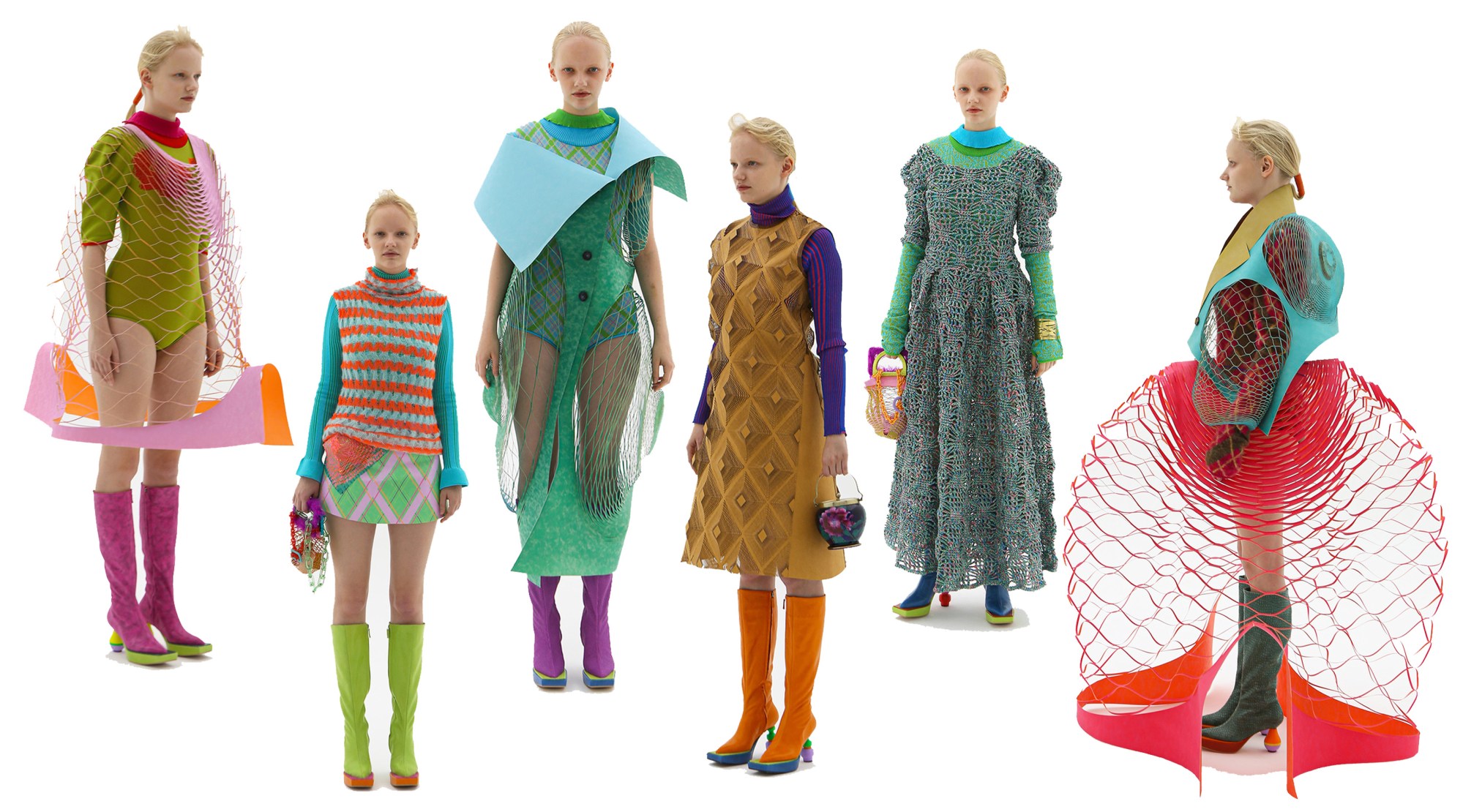No matter what fashion school you look at, never will there be a graduating class quite like 2020. Swiftly dismissed from their studios about three months ago on account of the pandemic — disallowed access to the high-spec equipment, workshops and communities they’d till then relied on — they’ve had to navigate uncharted waters in both the production and presentation of their final collection.
At London’s Central Saint Martins, the school’s 106 BA graduates rose to the unforeseen challenge of creating six looks entirely in isolation at home, its MA students having graduated back in February. Though certain restrictions may have eased since the city entered lockdown back in March, bans on mass gatherings remain — the class was, therefore, the first to be denied the opportunity to present their work in CSM’s much-feted physical BA show. Instead, students self-produced 20-second videos which were compiled into a digital presentation.
Still, they more than rose to the occasion: the innovation and talent on show among this year’s class is deserving of rapturous applause — and would be even without the peculiar circumstances in which it’s now being released into the world. Here, we speak with ten of CSM’s Class of 2020 about their collection, the task of creating under lockdown and their thoughts on how fashion relates to today’s world.
Dahee Kim, Fashion Design with Print
“Growing up in South Korea, students have to comply with strict rules and standardised acts at school. They can’t express themselves visually. A perfect example is the Korean school uniform — there are strict rules on skirt lengths and customisation, for example. For my collection, I drew inspiration from the abandonment of those rules, celebrating self-representation and individuality.
“While making it, I was quite self-conscious about a few things: Is this too big? Is this too ridiculous? But I was able to work with joy and confidence when I realised that it wasn’t about making a collection for other people. It was about showing who I am at the moment. If I can be honest about that, it’s a great starting point for respecting others and who they are, too.
“My ultimate plans for the future haven’t not changed, but our plans to celebrate by popping champagne and hugging classmates, friends, and tutors after the show have. The reality that I can’t even drink a can of beer with them is the biggest sadness of 2020.”
Yasmina Atta, Womenswear
“My collection explores the idea of a hybrid persona, combining mysticism with ideas of the future. Drawing inspiration from African cinema, in particular, the work of Djibril Diop Mambéty, I explore the surreal within a person that emerges from a post-colonial African identity. One of the ways I pursued that was by conveying a person shapeshifting.
“In retrospect, I’d also say that my work explores themes of otherness, as well as of being a multicultural person — my identity is a recurring theme in my work. Discussions on race, although emotionally painful, are extremely important in creating awareness and dialogue. I feel strongly about continuing to pursue ideas that reflect my identity and to also make sure I am celebrating other Black artists and working with Black artists actively.
“Working from home was difficult. Particularly at the start, it was hard to stay motivated, and I had to think of what I could do on my own within the constraints posed by time and lockdown. When I could I used materials from previous projects and I think I became more resourceful during the making process. I was more open to resolving issues and changing design ideas rather than being fixed on a specific end goal.”
Jisoo Jang, Fashion Knit
“If you look at my collection, you might ask what the logic behind it is, because there are so many various materials, colours and shapes. The best answer would be that it shows my personality. I’m the sort of person who buys a flower and puts it in a vase that matches its scent and appearance.
“I am very interested in various items and deliberate over collecting precious, valuable things. A lot of products are coming out these days, but I want to talk about the importance of thinking about our consumption and how we can make our future on Earth a happy one.
I tested lots of new materials to develop sustainable techniques in this collection such as zero waste pattern with laser cutting on washable paper, as well as bioplastics made using cornstarch and jesmonite.
“Finishing the collection was really difficult. I used to work in CSM’s digital fabric bureau, where I did lots of experimental tests and had conversations with staff. After uni closed, I had to come back to my country and find a new place to do laser cutting. It was hard working with new people in such a short time, and I also had to do some hand cutting. One thing I liked, though, was that I could collaborate with my mom during quarantine which I never imagined in London.”

Anthon Raimund, Womenswear
“Throughout my time at CSM I’ve been developing a character from photoshopped images of myself. This started off as a parody, but led to a portrait for the Royal Academy’s Summer Show and now my graduate collection, ‘Social Climbing’. The clothes are all about being ostentatious and unapologetically glamorous, just like the women they are designed for. I think there’s nothing more fabulous than a 40-plus lady with eccentric taste and I wish that fashion would celebrate the more mature women that actually buy the clothes rather than trying to sell youth.
“One of the most important features of the design is the exaggerated body proportions. I used hidden padding, corsetry and huge platform heels to mimic the warped, Facetuned bodies we see all over social media. I wanted to push past normal beauty standards and create a futuristic, intimidating woman. It was also really important to me to use digital printing in my work, this was a way for me to incorporate my photoshop work and give a contemporary online spin to the clothing.
“Fashion will often reflect the times in which it is worn, and I’m very inspired by what I see online. Identity has never been so fluid as it is in an online space and social media gives you the opportunity to create your own world and show whatever you want to show. In my own work, I always try to make something fun and empowering, always with a touch of humour. Especially in these troubled times, I think it’s so important for everyone to have some fun and a little dress-up is the perfect way to do that.”
Sandra Poulson, Fashion Design with Print “My final collection, AN ANGOLAN ARCHIVE, is an archival assemblage of information explored through documents, artefacts, garments, moments, headlines, oral tradition, and historical data that define the sociocultural, economic, political, ethnic and cultural landscape of Angola, focusing on Luanda. It mostly uses a selection of common Angolan household items — the Cuca Beer Crate, the President T-shirt and the cloth used by women to wrap around the body — to discuss the relationship between family and inherited societal memory from colonial Angola and the civil war.
“At the beginning of lockdown it was really challenging to even imagine how to continue working without access to workshops. This was particularly due to the large scale of some of the items. Eventually, after a month of debating with myself about using a disused roof terrace of the building next to my flat, I decided to occupy it, beginning the gesture of ‘Roof Occupation’, using it as my studio, medium, and, to some extent, subject.
“My practice has always been focused on micro-political moments and tensions and how they relate to macro-politics. It focuses on analyses and discussions about the colonial relationships between Africa and the West. It therefore demands decoloniality as a praxis, a lifestyle and a mission that we all have to adhere to. The moment we are currently living is offering us an opportunity for this conversation to be ‘The Conversation’ — but it always should have been. What is important to reiterate is that this fight is not a trend. The fashion industry should be taken accountable at all levels as the problem systemically affects all stages of employment, design, production, marketing and profit-generation. To dismantle its racism, the industry and people within it will need to revisit themselves and take real progressive steps rather than ticking boxes once again.”
Pablo Rousson, Menswear
“I’d introduce my collection as ‘Heidi meets Man’, and it’s mostly an embodiment of myself, and my humour. Until recently, menswear has always been quite a traditional world, so my instinct has always been to push it as far as it can go without coming off as a gimmicky. Another theme was exploring ideas of male erotica from a new angle. I think we’re in an era where sexuality and gender are so open, and that there are so many new ideals of what makes someone sexy. I’m obsessed with playing with the ideals of what we traditionally find sexy on women and applying that to menswear. There are also more literal references like my Swiss-Bavarian heritage, and less obvious ones to artists like Joseph Beuys, Richard Prince and Thomas Ruff.
“Working during lockdown was easier than I initially thought it would be, but the main thing that really got me down was missing out on being together in our last months as a year. The studios were insane when we were at uni. You had Bradley Sharpe screaming at one end of the studio about his lost tent poles 85 percent of the time, Chet Lo basically stripping on every knit machine in sight, and Sam Pomeroy making sure the menswear studio was basically a club from 6pm every day. We missed out on probably some of the best memories we would’ve had for life.
“Having made so much more than just clothes for the final collection, and shot everything myself, I really want to get into the post-production of fashion, whether that’s by assisting photographers or working with the visual branding teams of companies. Let’s see, though — my Gemini mind is in 15 different places right now. Yesterday, I wanted to be a ‘fashion florist’; today I want to move to Tokyo…”
Carl Gustaf von Platen, Womenswear
“My collection is an attempt at swallowing tradition and digesting it, breaking it down with my bodily acids to then excrete it as something beautiful. Like so many other designers, I naturally felt my first collection had to be entirely charged with who I am, from the heart and gut. In broader strokes, its central theme is heritage, specifically the esoteric importance of taste and manner that I was taught growing up in Sweden. When I say ‘the importance of taste’, I mean all aspects of the word, from the tongue outwards.
“Personally, as a fashion designer, I think it’s quite difficult to successfully intellectualise and politicise the actual garment design process. The cut of a jacket, nor the placement of a zipper can ever correct the fundamental inequalities that exist in society. That being said, I do believe the framework and context surrounding the design can be impactful, in tandem with how you choose to distribute your capital, whether social, economic, or cultural. Being aware of the realities of what you choose to do is important.
“I found it was rather difficult to make the collection to the degree I wanted to, as I was quite reliant on having the separation between home and studio — I don’t like having pins in my bed or wisps of wool on my socks.”
Zanna Messenger-Jones, Fashion Knit
“I took a personal approach with my collection, which was difficult in some ways and required a lot of emotional work. I decided to explore my identity as a profoundly Deaf person, and how I fit within the hearing and the Deaf worlds. I investigated Deafness and my experiences within it, and allowed conversations with Deaf friends and their experiences to inform my work, too. I wanted to bring awareness to the isolation that deafness can bring in a predominantly hearing world, and the importance of inviting both hearing and Deaf people to British Sign Language and allowing these barriers to be broken down.
“I’d describe my final pieces as low waste knitwear for colourful individuals, which draw inspiration from sportswear silhouettes and combine them with traditional techniques such as crochet and weaving. There were some materials I couldn’t get hold of at all, so parts of my designs had to change quite a lot, but I took on the challenge the best I could and used what was around me, which allowed me to keep being sustainable. I really missed the studios, CSM is such an amazing place that allows its students to form a little family, we push each other and support each other.
“I intended the garments to be non-binary and using my family members allowed me to show the garments on varying ages, genders and body types. I’m also well aware of my privilege as a white person, especially in a predominantly white industry, and I’m continuously learning and unlearning by listening to BAME experiences and educating myself, while having conversations about race with those around me. Within my work, I draw awareness to disabilities and Deafness, and with that race must be a part of the conversation. My white Deaf voice is still a white voice and I intend to use my platform to allow BAME voices, Deaf or otherwise, to be heard and acknowledged.”
Sophie Cheah, Menswear
“A central theme I wanted to explore in my collection was mundanity. I was drawn to this idea of places and situations that are beautiful without trying to be, which is really exciting to me. I used to think I came from such a boring and uninspiring place in Toronto, Canada, but since moving away for university I’ve learned to appreciate its unintentional raw beauty.
“It also explores elements of my second-generation Chinese heritage. For me personally, my Chinese family is something I’ve tried to hide, in both my identity and my creativity. Growing up, I used to do things to make myself look and feel less Chinese. Living in London, attending CSM and the current cultural wave of conversations surrounding identity have made me comfortable to embrace and celebrate my Chinese family. I used imagery of my Chinese grandmother as reference points for my designs and the lettering used in the video is my Chinese name she gave to me when I was born. The collection is a coming of age for myself and as much a fashion collection.
“As a female designer making menswear, it’s impossible to create a collection without it being in some way a response to the current conversations surrounding identity. My work is so heavily influenced by sexuality, race, identity, gender because my own life and experiences have been too. The collection very much was inspired by my own identity and my own acceptance of who I am. I do hope that if someone likes it, it could hopefully provide comfort or inspiration for them too. And for anyone offended by it, a bit of a ‘fuck you’.”

Slid Needham, Womenswear
“My collection, Birth², is an autobiographical account. It’s a physical embodiment of: the ‘trans’ experience; of society’s longing for the compartmentalisation of our bodies, both pharmaceutical and pornographic; of the machine’s dissection of the hyperfeminine, an overly saturated and overtly fetishised target.
“My work comes from my experience and the perspective of a trans body, my queer identity. It’s about the journey from personal conception to birth, and the act of truly living your gestation period. I wanted to explore the sexualisation of a body that is hated as much as it is adored. I looked into sex technologies and sex dolls and the ideas of pre-packaged bodies for pleasure. It’s a dark tale of a ‘man-made’ world taken over by womankind.
“I think you should always listen and learn from your peers and your community, from people of all backgrounds — respect is key. I hope my work can speak to people and I hope I can share my experiences with people I have met and will get to meet. As a trans person, I would love to spotlight trans bodies and trans voices to show more honest diversity in fashion.”
Credits
All videos and imagery courtesy of credited students
Anthon Raimund credits
Stylist Lily Bling
Photographer Raphael Bliss
Makeup and Nails Maria McKenna
Wigs James Oxley
Set Design Maria Vorobyeva
Assistant Javier Imber
Millinery Collaboration Leo Carlton Headwear (Looks 3 and 6)
Jewellery Pebble London and The Hirst Collection
Lingerie Construction Aimee Maynard (Look 1)
Model Ayana Behati

